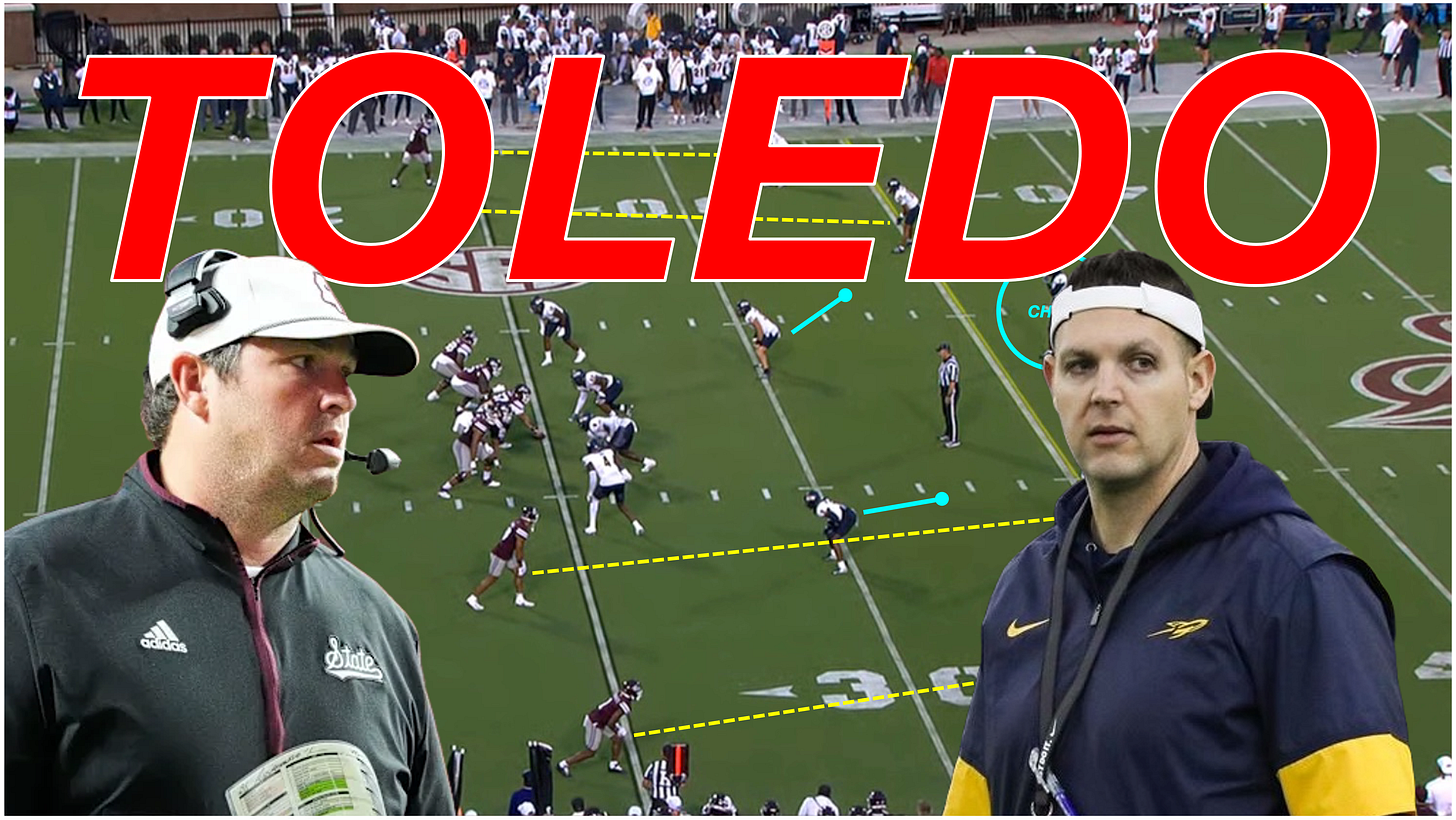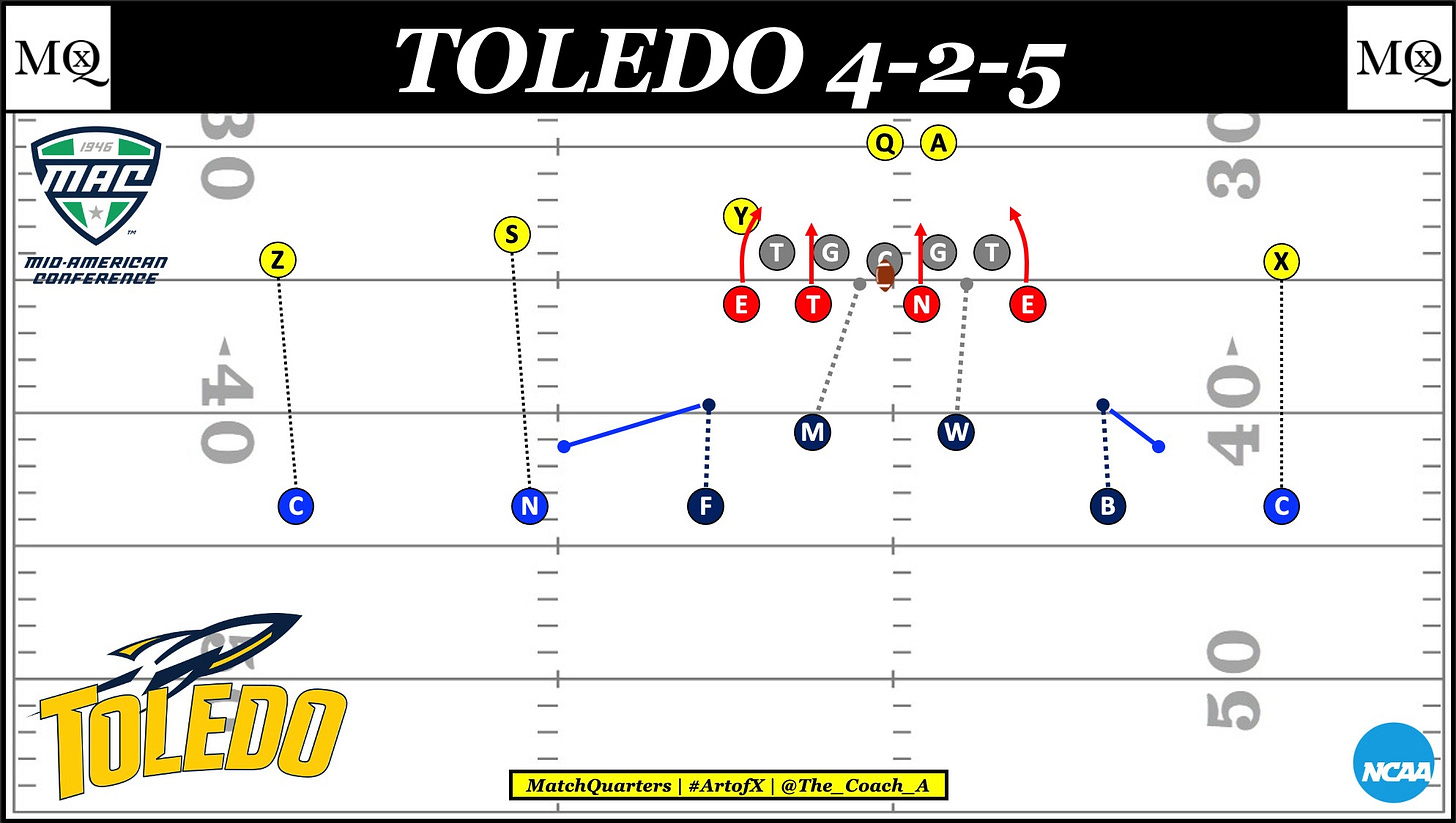Toledo vs. Mississippi State Cut-Up
It was a 41-17 beatdown in Starkville, with the Rockets' defense illustrating why it is one of the best defensive schemes in college football.
It was a relatively down year for the Toledo Rockets under Head Coach Jason Crandle. Toldeo started the year 3-0 with a marquee win against SEC opponent Mississippi State. Inconsistent offensive play plagued the Rockets all year; they finished 108th in OFEI. But a six-overtime victory against ACC opponent Pitt capped off an eight-win season.
The last time the Rockets won eight-plus games in a row for three seasons was in 2017. Last year’s 11-win season was the most since that ‘17 campaign. Crandle has built sustainable success with a backbone rooted in defense.
The Mid-American Conference (MAC) may not have the offensive prowess of other G5 conferences, but some of the best defensive minds get their start here. Toledo runs a unique version of a 4-2-5 that features a five-across alignment. The defense is akin to the popular four-down three-high system run by Jim Knowles in Columbus, now Penn State.
The main difference is that the Rockets have not modified an Odd Stack structure. Defensively, under Vince Kehres, Toledo is more of a traditional 4-2-5 that uses its two Safeties as levers. To the Nickel side (field), the defense runs a version of Bracket, with the Ni playing a MES (man except shallow) concept on Slot, with the Safety as the primary force player near the box from depth. To the boundary, the Safety sits in the Glance window while the CB is playing essentially man on the single receiver.
The two Safeties act like vices on the running back and block any in-breaking route that may come across their face. In the modern college game, in-breaking RPOs, play-action passes, and Y-off formations are popular. Toledo has devised a way to play clog the middle of the field and force quarterbacks outside and deep.
The system is Quarters-based, but the structure and personnel allow Kehres to transition into closed post coverages easily. The Rockets were still Quarters-dominant this past year, but were almost 50/50 for open and closed post coverage usage. The five-across secondary and coverage-dominant Ni allows Toledo to mix and match their coverages (and defenders) to leverage their opponents' talent.
Blitzing is not a large part of the Toledo scheme. Kehres uses his defense like a vice, squeezing the space from the field and forcing offenses into low-percentage players. When the Rockets do send pressure, they like to use their secondary. Above, Toledo is well below the average when it comes to ‘box’ or linebacker pressure. Like any 4-2-5 defense, Nickel pressures are a large part of their scheme, but they are still below the FBS average.
Where they are higher than average is in six-man blitzes. Toledo inherently runs nine-man spacing Quarters, which means the secondary often ends up in man coverage across the board. It makes sense that Kehres would lean into that already-established look and use six-man blitzes with Cover 0 behind them.
Against Mississippi State, Toledo faced an SEC opponent whose offense is one of the more popular schemes in the country. Head Coach Jeff Lebby stems from the Briles (Baylor) tree and has worked under Ole Miss’s Lane Kiffin. The system is a mesh between the greatest hits from the West Coast and Briles’ Air Raid schemes.
Toledo’s defense is perfectly designed to handle this type of system. With five across the backend and a mixed bag of Quarters and Match 3, the Rockets could dictate where the space was on the field, funneling the ball to predictable areas. Many times, the only free space was in the low Seam.
Modern offenses don’t want to live on five-yard hitches to the Slot, where the Bulldogs were forced to go. The secondary was also prepared for the deep shots, which Quarters allowed them to cap. The game was an excellent study in space mitigation by a ‘lesser’ talented team against an offensive scheme that has proven to score points.
Base Defense Cut-up
Keep reading with a 7-day free trial
Subscribe to MatchQuarters by Cody Alexander to keep reading this post and get 7 days of free access to the full post archives.







